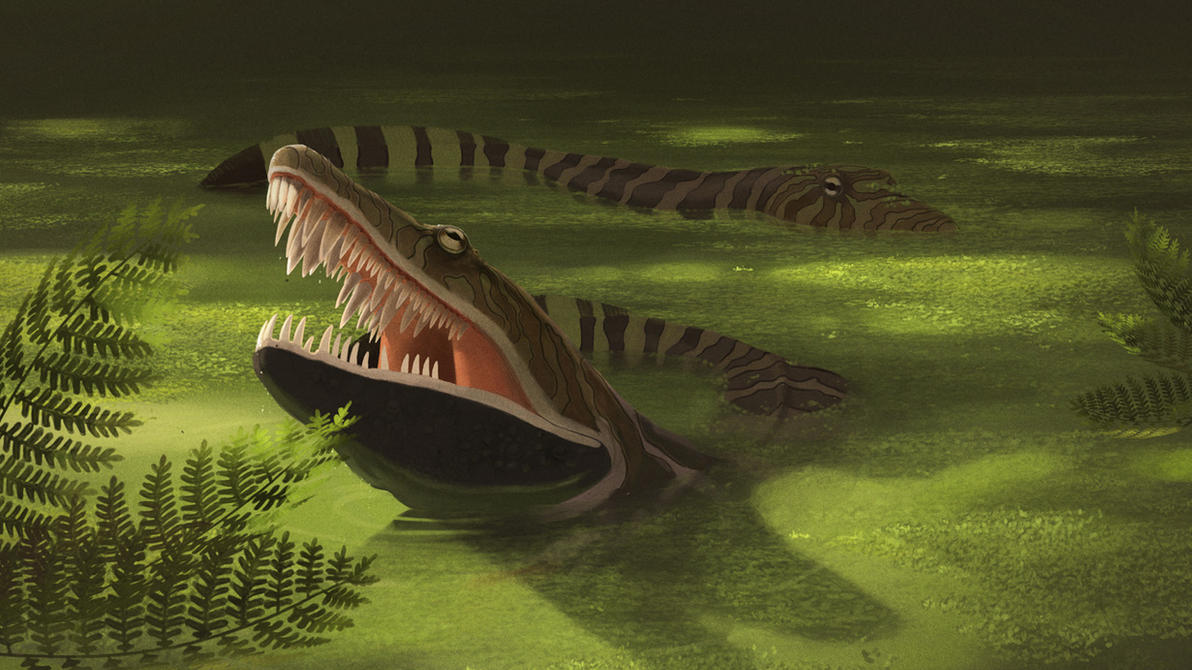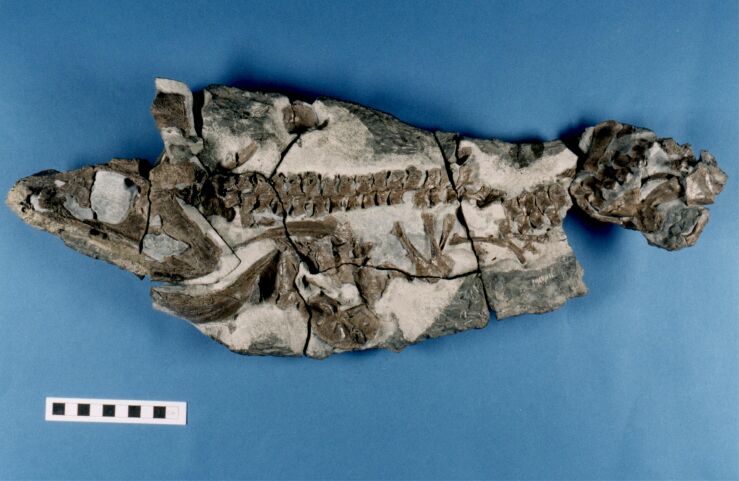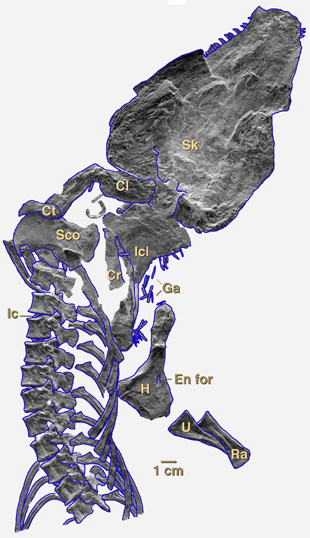[Recent Entries][Archive][Friends][User Info]
October 5th, 2011
| October 5th, 2011 | |
|---|---|
| 05:17 pm [industrialterro] [Link] |
Pseudophlegethontia Pseudophlegethontia is an extinct genus of aïstopod lepospondyl. It is the only member of the family Pseudophlegethontiidae. The only species is the type species P. turnbullorum, named in 2003. Fossils of Pseudophlegethontia have been found from the Mazon Creek fossil beds in Grundy County, Illinois, a conservation lagerstätte well known for the exceptional preservation of middle Pennsylvanian taxa. Pseudophlegethontia has been considered to be morphologically intermediate between derived phlegethontiids and more basal "ophiderpetontids" such as Ophiderpeton. It possesses basal characters such as a relatively short body, "k shaped" ribs, and distinctive skull roof bones while also possessing several more derived features such as a pointed snout, thin gastralia, and a lack of dorsal osteoderms.
Tags: Вымершие амфибии, Карбон, Лабиринтодонты, Лепоспондилы |
| Time | Event |
| 05:22 pm [industrialterro] [Link] |
Tuditanus Tuditanidae is an extinct family of tuditanomorph microsaurs. Fossils have been found from Nova Scotia, Ohio, and the Czech Republic and are Late Carboniferous in age. Tuditanids were medium-sized terrestrial microsaurs that resembled lizards. Postcranial material is best known from the genus Tuditanus, showing that it had size, proportions, and skull configuration that were similar to captorhinids. Tuditanids have also developed an astragalus in the ankle (a reptilian feature) from the fusion of several other bones. In comparison to other microsaurs, tuditanids were short-bodied, with fewer than 30 presacral vertebrae. The limbs are large and well developed. Unlike other microsaurs such as gymnarthrids, the jaw articulation is at the posterior margin of the skull. The teeth are blunt and peg-like. Tuditanids are thought to have had a similar lifestyle to reptiles such as captorhinids. They were terrestrial and likely fed on insects and other small arthropods. The similarity between tuditanids and contemporary reptiles may have contributed to their rarity in the Late Carboniferous and their relatively early extinction before the start of the Permian.
Tags: Вымершие амфибии, Карбон, Лабиринтодонты, Лепоспондилы |
| Time | Event |
| 05:27 pm [industrialterro] [Link] |
Caerorhachis Caerorhachis (meaning "suitable spine" in Greek) is an extinct genus of early tetrapod from the Early Carboniferous of Scotland. Its placement within Tetrapoda is uncertain, but it is generally regarded as a primitive member of the group. The type species C. bairdi was named in 1977. Caerorhachis has usually been placed as a basal anthracosaur or a close relative of anthracosaurs. In this classification, Caerorhachis is a close ancestor of amniotes, or tetrapods that lay eggs on land. Caerorhachis has also been classified as the sister taxon of temnospondyls, a large group of extinct amphibians, based on the presence of several primitive traits. In fact, when it was named in 1977, Caerorhachis was thought to be a dendrerpetontid temnospondyl. The vertebrae of Caerorhachis are more similar to anthracosaurs, however. As in all early tetrapods, the centrum, or central part of the vertebra, is composed of two parts: the intercentrum and the pleurocentrum. While temnospondyls have large intercenta and small pleurocentra, Caerorhachis and anthracosaurs have larger pleurocentra than intercentra. A 2003 phylogenetic analysis of early tetrapods placed Caerorhachis outside the clade that included temnospondyls and anthracosaurs in an ancestral position to both groups. Caerorhachis is thought to have had a primarily terrestrial lifestyle. It lacks the lateral lines across the skull that served as an adaptation for earlier aquatic tetrapods and their ancestors. The large, well developed limbs suggest it was able to move on land better than other early tetrapods like colosteids and baphetids. Robert Holmes and Robert L. Carroll, the first to describe Caerorhachis, interpreted it as "[an] animal spending much of its life in the damp mud on the margins of ponds or streams, feeding on stranded fish, or occasionally venturing into the water to catch aquatic larvae of other amphibians."
Tags: Антракозавры, Вымершие амфибии, Карбон, Лабиринтодонты |
| Time | Event |
| 05:48 pm [industrialterro] [Link] |
Anthracosaurus Anthracosaurus is an extinct genus of labyrinthodont that lived in the Carboniferous period. Anthracosaurus belongs to the suborder of Embolomeri. Anthracosaurus from the Late Carboniferous some 310 million years ago, was a large, aquatic eel-like predator. It could reach up to 12 feet in length, and its jaws were full of sharp teeth. Anthracosaurus inhabited swamps, rivers and lakes in what is now Scotland. Its name is Greek for "coal lizard".
Tags: Антракозавры, Вымершие амфибии, Карбон, Лабиринтодонты |
| Time | Event |
| 06:01 pm [industrialterro] [Link] |
Diplovertebron Diplovertebron is an extinct genus of Anthracosauria (Labyrinthodont) that lived in the Late Carboniferous period (Moscovian) (300 million years ago). Diplovertebron was a medium-size animal, 60 cm in length. Its skull produced a tapering triangle, like a small-scale replica of a crocodile's skull. The otic notches in the posterior part of the skull, which are normally present in primitive amphibians, were very small in Diplovertebron, but the structure of the vertebrae was very primitive and the notochord persisted into adulthood. The limbs were sturdy, but lightly built and had five digits. The carpal or 'wrist' and tarsal or 'ankle' bones were cartilaginous, and did not ossify. The limbs were used mainly in water, where hydrostatic pressure reduced the weight of the body. Diplovertebron punctatum inhabited European Carboniferous swamps (nowadays Czech Republic), where it caught fish and smaller amphibians. Another, closely related species, lived in the Pennsylvanian period in North America. Diplovertebron is an important link in evolution, because its body structure resembled that of a reptile. В карбоновых болотах Европы и Северной Америки обитали лабиринтодонты из очень интересной группы антракозавров (Anthracosauria). Здесь изображен европейский антракозавр рода Diplovertebron, не превышавший в длину 70 см. Обладая уже вполне развитыми пятипалыми конечностями, он предпочитал, тем не менее, добывать пропитание в воде. Антракозавры были важным звеном в эволюционной цепи, так как строение их тела уже весьма сходно с таковым пресмыкающихся. Предполагают, что пресмыкающиеся, а с ними и все высшие наземные позвоночные, происходят от антракозавров.
Tags: Антракозавры, Вымершие амфибии, Карбон, Лабиринтодонты |
| Time | Event |
| 06:13 pm [industrialterro] [Link] |
Gephyrostegus Gephyrostegus is an extinct genus of reptile like amphibians or possibly an early proto-reptile. It was a small animal of generally lizard-like build and presumably habit. It had large eyes and a large number of small, pointed teeth, indicating it was an active insectivorious hunter. The remains have been found in Nyran, Czech Republic, dating from around 310 million years ago (upper Carboniferous). Originally thought to have been an seymouriamorph, the phylogenetic position is uncertain, and it now has its own family: Gephyrostegidae. At 22 cm snout-vent length, Gephyrostegus is one of the smallest (if not the smallest) advanced reptiliomrphans found, and is one of several candidates for having evolved an amniote egg, thus being the first reptile. The original find was that of a fairly complete skeleton. The species Diplovertebron watsoni, erected for two smaller, possibly juvenile individuals, have been reassigned to Gephyrostegus. If the two smaller specimen are indeed juveniles of the same general build animals as the first find, it indicates Gephyrostegus did not have a free tadpole stage, with implications for its status as a possible reptile. Гефиростегиды (Gephyrostegida) — отряд (или подотряд) примитивных четвероногих карбона и, возможно, перми. Близки к настоящим антракозаврам и сеймуриаморфам. Вероятно, происходят от антракозавров, в отличие от них, лишены зубов на поперечных отростках птеригоидов. Строение скелета чрезвычайно сходно с таковым у примитивных амниот — тело короткое (24 позвонка), ноги довольно длинные. Плевроцентры позвонков крупные, интерцентры мелкие. Кости черепа скульптированы, скульптура в виде бороздок и ямок (может указывать на отсутствие фолидоза). Довольно развита «ушная» вырезка, стремя тонкое. Зубы не лабиринтодонтные. По-видимому, наземные или полуводные насекомоядные. Размеры тела мелкие — длина не более 40—45 см. Единственное семейство Gephyrostegidae с двумя родам и видами:
Род Eusauropleura из позднего карбона Северной Америки и Чехии может также относиться к гефиростегидам. М. Ф. Ивахненко относит к гефиростегидам также энозухов из поздней перми Восточной Европы. Близок к этой группе также Solenodonsaurus из позднего карбона Чехии. Гефиростеги — самые близкие к амниотам представители примитивных четвероногих, они вполне подходят на роль предков настоящих амниот. Тем не менее, даже самые древние гефиростеги жили достаточно поздно, чтобы быть прямыми предками амниот.
Tags: Антракозавры, Вымершие амфибии, Карбон, Лабиринтодонты |
| Time | Event |
| 06:27 pm [industrialterro] [Link] |
Cochleosaurus Cochleosaurus is a name of a tetrapod belonging to Temnospondyli, which lived during the late Carboniferous period (Moscovian, about 310 millions years ago). The great abundance of its remains (about 50 specimen) was found in Czech Republic, near Nýřany. It was a creature of medium size, measuring 120-160 centimeters. It is believed that Cochleosaurus was a semi-aquatic ambush predator, hunting like modern crocodiles. Эдопоиды (подотряд Edopoidea). Разнообразная группа пермокарбоновых примитивных темноспондилов. Исходно — полуназемные формы, позднее появились преимущественно водные. Кохлеозавры (сем. Cochleosauridae) — 5-6 родов из позднего карбона — поздней перми Европы, Северной Америки и Африки. Наиболее известный род — кохлеозавр (Cochleosaurus). Описаны два вида — C. bohemicus и C. florensis, из позднего карбона Богемии и Новой Шотландии соответственно. Это относительно крупный (длина черепа до 16 см, общая длина до 1,5 м) крокодилоподобный темноспондил. Череп у взрослых с относительно длинной мордой, у молодых особей — округлый. Крыша черепа покрыта ячеисто-сетчатой скульптурой, имеются (особенно у C. florensis) вдавления между глазами, гребни позади глаз. Ноздри сдвинуты назад, длинный прехоанальный отдел. Заднетеменные кости образуют направленные назад отростки. Теменное отверстие очень маленькое. Небные ветви крыловидных костей не соприкосаются друг с другом. Слезная кость не достигает глазницы. Вероятно, кохлеозавры были доминирующими водными хищниками своего времени.
Tags: Вымершие амфибии, Карбон, Лабиринтодонты, Темноспондилы |
| Time | Event |
| 06:38 pm [industrialterro] [Link] |
Pederpes Педерпес (Pederpes finneyae, Pederpes finneyi) — примитивное четвероногое («земноводное») начала раннекаменноугольной эпохи. Единственное четвероногое этой эпохи, известное по достаточно полному скелету. Педерпес заполняет так называемый «провал Ромера» — промежуток примерно в 20 миллионов лет между поздним девоном (временем существования примитивных водных тетрапод вроде ихтиостеги и акантостеги) и появлением настоящих четвероногих в раннем карбоне. Скелет педерпеса обнаружен в отложениях турнейского времени (около 354—344 млн лет назад) в Шотландии. Обнаруженный в 1971 году, скелет долгое время хранился в запасниках музея в Глазго как остатки рипидистии-ризодонта. Доктор Дженнифер Клак и ее сотрудники из Кембриджа обнаружили, что остатки принадлежат четвероногому. Описание, принадлежащее перу Д. Клак, было опубликовано в 2002 году. Педерпес достигал в длину около 1 метра (длина сохранившегося скелета — 65 см, хвост утрачен). Он обладал массивным высоким и узким черепом с мощными зубами. Борозды боковой линии погружены в кость в виде каналов (как у кистеперых), стремя сходно со стременем акантостеги. «Ушная вырезка» (в действительности, вероятно, вмещавшая брызгальце) неглубокая. Присутствуют «клыки» на сошниках, небо покрыто мелкими зубчиками, закрытое. Позвонки рахитомные. Ребра расширены, напоминают ребра ихтиостеги. Конечности очень массивные, относительно короткие. Не исключается наличие добавочных пальцев на кисти, стопа пятипалая. Строение конечностей в целом напоминает их строение у более поздних тетрапод — то есть, педерпес мог передвигаться по суше. Педерпес — хороший пример того, как могли выглядеть предки наземных тетрапод. В отличие от девонских терапод это животное обладало настоящими ногами. По сути, это первое из известных нам животных с настоящими ногами. Его нельзя отнести ни к одной из групп «земноводных», он находится где-то в основании ствола настоящих тетрапод. Родственником педерпеса может быть род Whatcheeria, описанный в 1995 году из несколько более поздних отложений раннего карбона Айовы. Вместе их объединяют в семейство Whatcheeriidae. Это самые примитивные из последевонских тетрапод. По образу жизни, вероятно, педерпесы и ватчирии были полуназемными хищниками. Они могли охотиться на рыбу и крупных беспозвоночных.
Tags: Ватчирииды, Вымершие амфибии, Карбон, Лабиринтодонты |
| Time | Event |
| 06:50 pm [industrialterro] [Link] |
Whatcheeria Whatcheeria is an extinct genus of early tetrapod from the Early Carboniferous of Iowa. Fossils have been found in 340 million year old fissure fill deposits in the town of Delta. The type species W. deltae was named in 1995. It is classified within the family Whatcheeriidae along with the closely related Pederpes. Whatcheeria possesses a mixture of both primitive and derived traits. It shares with earlier stem tetrapods a series of lateral lines across the skull, rows of teeth on the palate, and small Meckelian foramina across the surface of the lower jaw. It has a cleithrum, a bone in the pectoral girdle that extends from the scapula. The cleithrum once attached to the skull in lobe-finned fish, the ancestors of tetrapods, but detached to allow the neck to move freely. Whatcheeria grew to about 1 metre (3.3 ft) long. The skull is deep and the snout is pointed. A hole on the top of the skull behind the eyes called the parietal foramen is relatively large in Whatcheeria. The bones on the skull surface are unusually smooth, unlike the pitted skulls of many other early tetrapods. In front of the eye socket, the prefrontal bone forms a prominent ridge. The prefrontal also projects downward to cover a possible sinus.
Tags: Ватчирииды, Вымершие амфибии, Карбон, Лабиринтодонты |
| Time | Event |
| 06:59 pm [industrialterro] [Link] |
Hyloplesion Hyloplesion is an extinct genus of microbrachomorph microsaur. It is the type and only genus within the family Hyloplesiontidae. Fossils have been found from the Czech Republic near the towns of Plzeň, Nýřany, and Třemošná, and date back to the Middle Pennsylvanian. The type species is H. longicostatum, named in 1883. Two species belonging to different genera, Seeleya pusilla and Orthocosta microscopica, have been synonymized with H. longicostatum and are thought to represent very immature individuals. Hyloplesion was about as large as a medium-sized salamander, with the length of known specimens ranging from 17-77mm. The skull is triangular in shape. Unlike many other microsaurs, the palate of Hyloplesion contains large vacuities, or openings. The fifth maxillary tooth is enlarged and resembles a canine. The skull of Hyloplesion superficially resembles that of the unrelated romeriid reptile Romeria in lateral view due to similarities in the pattern of the dermal bones and the hooked shape of the premaxilla. However, the skull differs from that of Romeria in dorsal view, as the parietals are much wider in Hyloplesion. The atlas arch also resembles those of romeriids and, unlike other microsaurs, is unswollen. The trunk is elongate, with thin ribs extending from each vertebra. The presence of a large scapulocoracoid in Hyloplesion distinguishes it from Microbrachis. The limb bones are small and robust, with the hindlimbs being quite larger than the forelimbs . Like other microbrachomorphs such as Microbrachis, Hyloplesion has only three digits in the manus, a condition known as tridactyly.
Tags: Вымершие амфибии, Карбон, Лабиринтодонты, Лепоспондилы |
| Time | Event |
| 07:04 pm [industrialterro] [Link] |
Solenodonsaurus Соленодонзавр (Solenodonsaurus janenschi) – примитивное четвероногое позднекаменноугольной эпохи. Ящерицеобразное животное длиной около 45 -60 см, с треугольной головой, острыми зубами. Зубы не «лабиринтодонтные». Вероятно, хищник или охотник за крупными насекомыми. Череп анапсидный, с неглубокой вырезкой, которая, вероятно, не служила для крепления барабанной перепонки. Конечности короткие, массивные. Невральные дуги, в отличие от сеймуриаморф и диадектид, невысокие. Есть брюшной панцирь из удлиненных чешуй, округлые спинные чешуйки. Описан Ф. Бройли в 1924 году из позднего карбона Нирани (Ниржани) в Чехии (Богемия). Известны несколько неполных скелетов, черепа плохо сохранились, что затрудняет установление родственных связей. Бройли считал соленодонзавра «котилозавром». Строение его позвонков (крупный цилиндрический плевроцентр, мелкие интерцентры) сходно с сеймуриаморфами, диадектами и ранними амниотами. Кладистический анализ показывает родство соленодонзавра с гефиростегами. Так или иначе, соленодонзавр представляет одну из многих ветвей так называемых «парарептилий», близких к амниотам, но не являющихся их предками.
Tags: Антракозавры, Вымершие амфибии, Карбон, Лабиринтодонты |
| Previous Day | 2011/10/05 [Archive] |
Next Day |




























